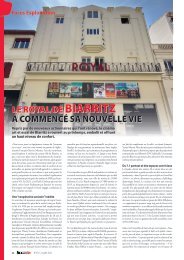Boxoffice Pro - Winter 2020
Boxoffice Pro is the official publication of the National Association of Theatre Owners
Boxoffice Pro is the official publication of the National Association of Theatre Owners
You also want an ePaper? Increase the reach of your titles
YUMPU automatically turns print PDFs into web optimized ePapers that Google loves.
Hispanic Heritage Month should play<br />
an integral part in our communities, our<br />
country, and, frankly, in our industry.<br />
What’s exciting to see is the dialogue<br />
starting to take place in our country<br />
relating to diversity and inclusion and the<br />
impact that it has, not only economically,<br />
but what it means for our country. We<br />
represent almost 60 million people in the<br />
United States. We are 18 percent of the<br />
population and growing rapidly; there’s a<br />
general feeling that we could be as much<br />
as 30 percent of the population within<br />
the next 10 years. That’s a significant<br />
number of the workforce, leadership,<br />
and consumerism of our future. In our<br />
industry, we’ve been able to recognize<br />
that already, knowing one out of four<br />
customers that comes through our door<br />
happens to be Hispanic or Latino. This<br />
month is a great way for our country to<br />
learn about the culture, the background,<br />
and also the potential economic impact<br />
that we represent today and will continue<br />
to represent in the future.<br />
In terms of frequent moviegoers—<br />
those that go to the movies most often<br />
throughout the year—Latin American<br />
moviegoers are over-indexed in terms<br />
of their share of the general population.<br />
Right now, we represent around 18<br />
percent of the general U.S. population,<br />
and Latin American audiences represent<br />
26 percent of frequent moviegoers. That’s<br />
more than any other ethnic group, by<br />
quite some distance.<br />
When I think about diversity and<br />
inclusion, there’s been an incredibly<br />
positive movement that’s taking place<br />
in our industry relating to women being<br />
recognized, behind the camera and<br />
in front of the camera. It’s also great<br />
that we’re now starting to see much<br />
more representation from the African<br />
American and Black communities,<br />
which is a tremendous and necessary<br />
improvement. They are also a huge part<br />
of the moviegoing population. But we still<br />
lack improvements that are necessary to<br />
see more Hispanic actors, directors, and<br />
producers. We over-index because we play<br />
a product that’s family-oriented, which<br />
relates to the consumer base. As you relate<br />
to consumers, I think it’s important that<br />
we also see ourselves, that our kids are<br />
able to see themselves on the screen. And<br />
by the way, that also applies to leadership<br />
positions within the film studios, and,<br />
frankly, within exhibition itself.<br />
“If you take a broader look<br />
and say, how many Hispanics<br />
sit on boards of directors<br />
at public companies in the<br />
United States, that number<br />
gets really small. It’s less<br />
than 2 percent.”<br />
I think that was the beauty of a movie<br />
like Black Panther. Kids could sit there<br />
and say, “That hero looks like me.” It’s a<br />
great way to not only create inspiration but<br />
also drive aspiration in our communities<br />
to chase leadership positions, acting<br />
positions, political positions, board of<br />
directors’ positions. These are areas that,<br />
unfortunately, diverse communities<br />
continue to lag in. The state of California is<br />
taking some interesting steps to correct that,<br />
but it shouldn’t be government driven. It<br />
should be done because it’s the right thing<br />
to do, to recognize the consumer base, and<br />
recognize where consumer growth is going.<br />
In exhibition, we’ve seen more<br />
representation because of the growth<br />
of Latin American circuits in the U.S.,<br />
which has introduced Latin American<br />
executives through that expansion.<br />
We have Hispanic executives among<br />
some of the leading vendors that<br />
service the exhibition industry. At the<br />
studio level, however, it is alarming<br />
that we don’t have that same<br />
presence. What is there left to do so<br />
we can see more of that diversity in<br />
other sectors of the industry—namely<br />
in production and distribution—<br />
that can hopefully influence more<br />
programming for Latin American<br />
audiences?<br />
I would start by saying that even in<br />
exhibition, as you noted, we have been<br />
very fortunate to have some very effective<br />
leaders and companies that are owned by<br />
Hispanics. But most of them started outside<br />
the United States. Even within exhibition,<br />
an industry that generated over $11 billion<br />
in 2019 in the U.S., a country with nearly<br />
60 million Hispanics, there’s more left to<br />
do. I’m very fortunate and grateful that I<br />
happen to be a Hispanic CEO, representing<br />
the fourth-largest circuit in the United<br />
States. But aside from that, if you take a<br />
survey, even within the top 20 circuits, you<br />
will not find many others.<br />
If we represent one in every four<br />
people that walk through the door in this<br />
industry, then it goes beyond just looking<br />
at the CEO level. How many Hispanic<br />
CMOs, COOs, or CIOs are there? It’s about<br />
leadership. If you take a broader look and<br />
say, how many Hispanics sit on boards<br />
of directors at public companies in the<br />
United States, that number gets really<br />
small. It’s less than 2 percent.<br />
<strong>Winter</strong> <strong>2020</strong><br />
21

















